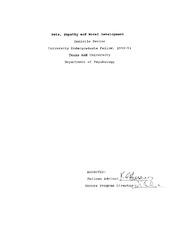| dc.description.abstract | This study explored the relationship between current and childhood pet ownership/bonding, and current levels of empathy and moral reasoning. The subjects completed the Mehrabian and Epstein Emotional Empathy Scale (1972), the Defining Issues Test (Rest, 1974) for moral reasoning, and the Companion Animal Bonding Scale (Poresky, Hendrix, Mosier, & Samuelson, 1987) for pet bonding. Females scored significantly higher than males on the empathy scale. A nearly significant trend was found for male pet owners to report higher levels of empathy than male non-pet owners, and for female pet owners to report lower levels of empathy than female non-pet owners. A trend was also found for those subjects who got their first pet during the psychoactive stages (before the age of six or after the age of ten) to report higher levels of empathy than those who got their first pet during other stages of development. | en |


